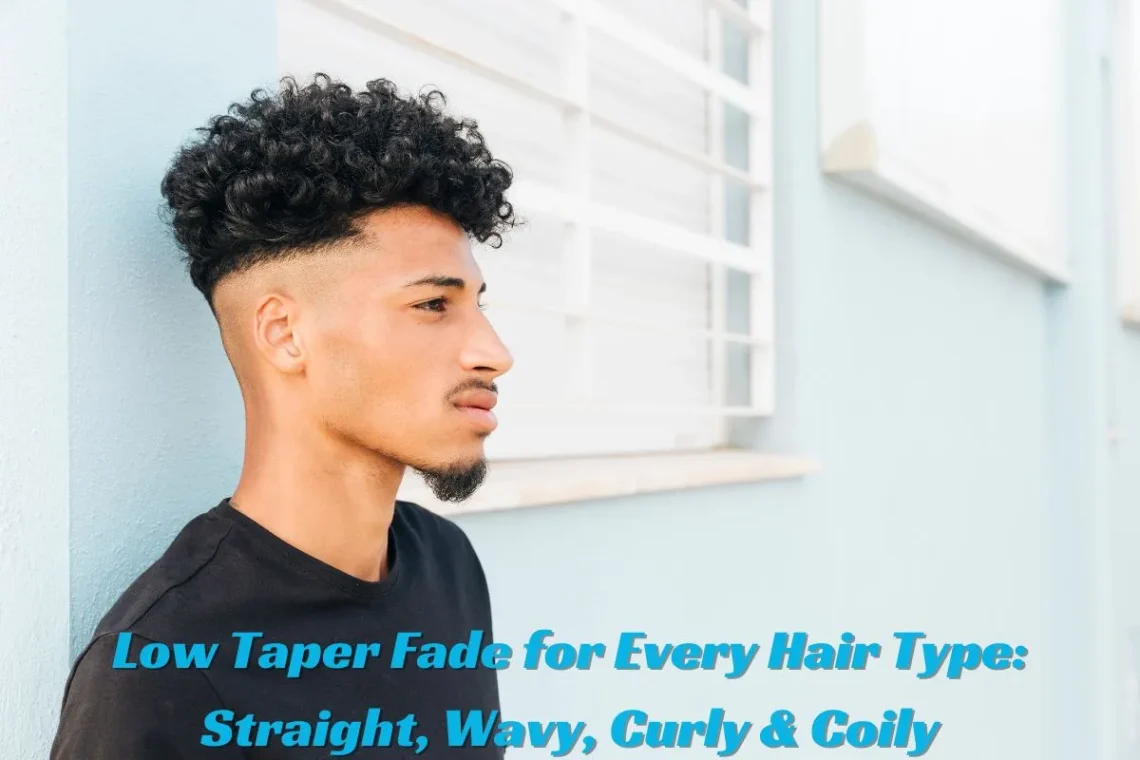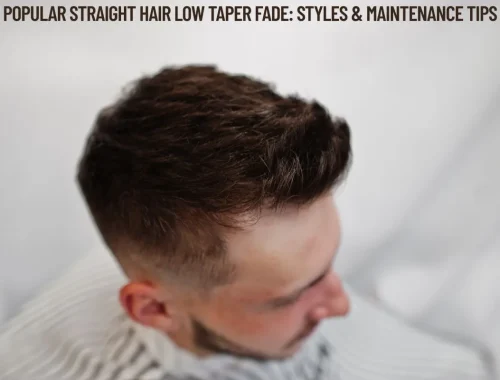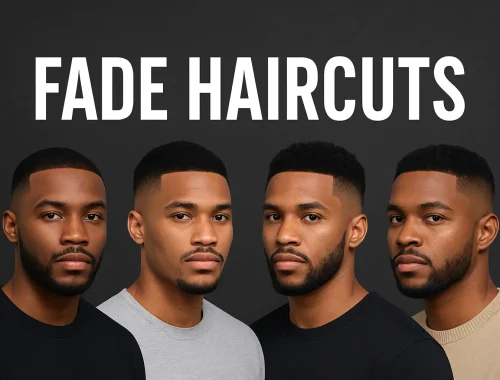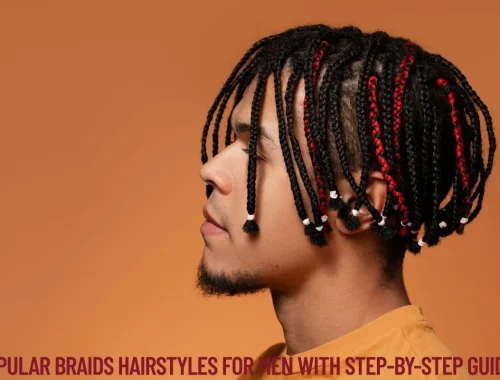
Low Taper Fade for Every Hair Type: Straight, Wavy, Curly & Coily
The low taper fade isn’t just a haircut—it’s a modern grooming statement that blends style, structure, and versatility. Whether your hair flows straight, bends in waves, coils in curls, or spirals tightly, this fade works across textures. It adds polish without taking away individuality, which is why it’s a favorite among barbers and clients alike.
In this guide, we break down how the low taper fade suits every hair type—straight, wavy, curly, and coily—and explore expert insights, studies on hair texture, real client experiences, and pro-level maintenance tips.
Table of Contents
ToggleWhat Is a Low Taper Fade?
A low taper fade starts at the lowest point of the hairline—usually just above the ears and neckline—and gradually blends upward. Unlike high or mid fades, it’s more subtle and softer, offering a professional, stylish look without going ultra-short on the sides.
“A low taper fade is a barber’s secret weapon for modernizing any haircut. It’s less aggressive than a high fade, making it universally flattering and perfect for those who want a clean, sophisticated edge without going too short on the sides.”
— David R. Smith, Celebrity Barber (VLCC)
Why the Low Taper Fade Works for Every Hair Type
Barbers love this cut because it’s adaptable. It can be customized based on:
-
Hair texture (straight vs curly)
-
Density (fine vs thick)
-
Shrinkage and growth patterns
-
Face shape and style preference
Let’s explore how it fits each hair type.
For Straight Hair: Sleek and Structured
Straight hair reveals every detail of a cut. That’s why precision is key.
“The beauty of the low taper fade lies in its seamless adaptability. For straight hair, it creates an incredibly clean, sharp line, offering a sophisticated and polished finish that’s hard to beat.”
— Julian Mendez, Master Barber, The Barber’s Den
Why It Works:
-
Sharp contrast between top and sides
-
Easy maintenance with minimal product
-
Works well for classic styles like pompadours or side parts
Barber Insight:
Alex Chen, international educator for Wella Professionals, adds:
“The key to a perfect low taper fade, regardless of hair type, is understanding the hair’s growth pattern and natural fall. It’s about meticulously blending to create that smooth transition.”
For Wavy Hair: Natural Texture, Elevated
Wavy hair carries natural movement, and the low taper fade enhances it instead of suppressing it.
“When working with wavy hair, the low taper fade is fantastic because it allows the natural movement and texture to shine on top while providing a crisp, well-groomed perimeter. It’s about enhancing, not fighting, the wave.”
— Maria Gonzalez, Stylist at Curl Collective
Why It Works:
-
Frames the face while leaving volume on top
-
Reduces bulk at the sides for a better shape
-
Enhances waves with defined edges
Case Study:
One client with thick 2B waves said:
“Before the fade, my hair looked heavy around the ears. Now the wave pattern stands out more, and the cut feels fresh, not floppy.”
For Curly Hair: Structured Freedom
Curly hair can look wild or weighed down without proper shaping. Enter the low taper fade.
“For curly hair, the low taper fade is a game-changer. It provides a clean canvas around the ears and nape, allowing the volume and definition of the curls on top to truly pop without looking unruly.”
— Kwame Jones, Barber & Educator, The Cut Academy
(BonoHair Guide)
Why It Works:
-
Makes curls appear fuller and more defined
-
Adds contrast to prevent a “mushroom” effect
-
Improves manageability and shape
Pro Tip:
Ask your barber to cut curls dry or with curl-specific methods like the “twist and cut” or “sectional snip” to avoid shrinkage surprises.
For Coily Hair: Clean Lines, Bold Volume
Coily hair—tight, springy, and full of personality—benefits immensely from a low taper fade that offers both structure and style freedom.
“Coily hair textures, with their unique shrink-factor and density, truly benefit from a low taper fade. It offers a clean, manageable foundation, making the top accessible for various styling options while maintaining a sharp, clean aesthetic.”
— Dr. Nina Jones, Trichologist & Founder of Afro-Hair Science
Why It Works:
-
Reduces bulk while preserving natural coils
-
Opens space for twist-outs, braids, or sponge styles
-
Less friction around ears and neckline (a plus for protective styles)
Supporting Studies on Hair Texture & Cutting Technique
While few academic papers focus directly on fades, research helps explain why tapering works differently across textures.
1. Hair Structure Study
A multinational study titled “Types and Characteristics of Hair Across the Globe” examined how hair texture varies by race, genetics, and follicle structure.
-
Straight hair: round follicles, smooth shafts
-
Wavy/Curly hair: oval or twisted follicles
-
Coily hair: flat or elliptical shafts, tighter curls
2. Hair Type Classification (Andre Walker System)
Used by stylists globally, this system classifies hair from Type 1 (straight) to Type 4 (coily), helping barbers tailor taper techniques based on texture and shrinkage.
3. Blending Techniques in Haircutting
Barbering education platforms emphasize the adaptability of fades. A good taper isn’t just about clipper skills—it’s about visual balance and respecting natural growth.
Maintenance Tips for Low Taper Fades (By Hair Type)
| Hair Type | Tip | Recommended Product |
|---|---|---|
| Straight | Trim every 2–3 weeks | Light hold pomade |
| Wavy | Use curl-enhancing cream | Sea salt spray |
| Curly | Moisturize regularly | Curl-defining gel |
| Coily | Hydrate and protect | Leave-in conditioner + edge balm |
Client Transformations: Real Talk
Case Study 1 – Straight Hair
Before: Flat sides, undefined shape
After: Tapered edges made his pompadour pop
“My fade actually made my whole face look sharper—it gave me that ‘clean-cut’ energy I was going for.”
Case Study 2 – Coily Hair
Before: Uneven bulk, no shape
After: Clean taper + high volume twist out
“Game-changer. I can wear my coils loud up top, and still look tidy around the edges.”
Expert Interview Highlights
We asked barbers from London and New York for quick tips:
Q: What’s your go-to move for straight hair?
A: “Clipper-over-comb, always. It gives razor-sharp lines without looking too drastic.” — Tom K., Shoreditch Barber Club
Q: How do you blend coily hair?
A: “Section, moisturize, stretch, fade. You have to prep the hair or the fade will look uneven.” — LaToya M., Harlem Cuts
Q: Biggest mistake people make?
A: “Requesting the same fade as their friend without considering texture. Your hair type decides your fade.” — Zahid R., Brick Lane Barber
Final Thoughts
Whether your hair spirals, coils, waves, or lies straight, the low taper fade is your go-to for fresh, stylish confidence. Its universal adaptability makes it a staple in barbershops worldwide.
So next time you’re in the chair, don’t just ask for a fade. Ask for one that works with your texture, not against it.
Because when the fade fits right, you don’t just look better—you feel unstoppable.
Want to keep your fade flawless?
-
Book regular trims (every 2–4 weeks)
-
Moisturize based on texture
-
Use edge control for definition
-
Talk to your barber—communication is everything
You May Also Like

Popular Straight Hair Low Taper Fade: Styles & Maintenance Tips
July 30, 2025
African American Fade Haircut Styles with Grooming Tips
September 4, 2025

